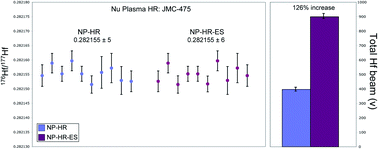Enhanced sensitivity in laser ablation multi-collector inductively coupled plasma mass spectrometry
Abstract
This contribution describes the analytical performance resulting from modifications to the source of a Nu Instruments ‘Nu Plasma’ high resolution Multi Collector Inductively Coupled Plasma Mass Spectrometer (MC-ICP-MS). Key advances in the ‘enhanced sensitivity’ (HR-ES) setup include changes to the geometry of the skimmer and sampler cones, re-design of the interface pumping system and modifications to the source lens. Comparison of both solution and laser-ablation data acquired on the same instrument before and after the modifications indicates that the sensitivity is improved by 80–125% in solution mode and 70–95% in laser-ablation mode. Analyses of standard solutions and reference zircon suggest no loss in accuracy. For laser ablation, the practical result is that for a given ablated volume, the HR-ES modification increases the precision with which individual isotopic measurements (e.g. U–Th/Pb, Hf) can be made. Conversely, for a required precision it reduces the amount of material needed by ∼2×, thereby significantly increasing the spatial resolution of in situ isotope MC-ICP-MS measurements.


 Please wait while we load your content...
Please wait while we load your content...